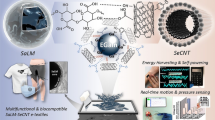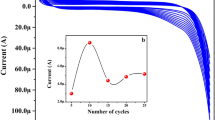Abstract
The electrochemical determination of copper (II), lead (II) and mercury (II) ions has been studied and analyzed in this paper. Preparation of polyaniline functional ink by electronic ink technology was proposed. Screen-printed carbon electrode (SPCE) modified by ethylene diamine tetraacetic acid @ polyaniline/multi-walled carbon nanotube nanocomposite structure was used as an electrochemical sensor by all-printed technology to selectively detect copper, lead and mercury ions. The improved electrode is a great improvement in process simplicity and practicability. Square-wave voltammetry was used to detect the concentration of copper, lead and mercury ions, and the selectivity, sensitivity, reproducibility and stability of the ions were also studied. The detection results show that the modified SPCE electrode has high selectivity, sensitivity and reproducibility. The detection limit of copper ions was determined as 55.4 pM, that of lead ions was 22 pM, and that of mercury ions was 17.8 pM.
Similar content being viewed by others
References
S. Chaiyo, E. Mehmeti, W. Siangproh, O. Chailapakul, and K. Kalcher, Anal. Chim. Acta 918, 26 (2016).
Z. Dahaghin, P.A. Kilmartin, and H. Mousavi, Food Chem. 303, 125374 (2020).
N. Sugawara, C. Sugawara, M. Sato, H. Takahashi, and M. Mori, Pharmacol. Toxicol. 71, 321 (1992).
S. Lal, K. Prakash, S. Hooda, V. Kumar, and P. Kumar, J. Mol. Struct. 1199, 127003 (2020).
X. Wang, X. Ma, J. Wen, Z. Geng, and Z. Wang, Talanta 207, 120311 (2020).
T. Ahmadi, S. Bahar, G. Mohammadi Ziarani, and A. Badiei, Food Chem. 300, 125180 (2019).
Y. Guo, J. Li, X. Zhang, and Y. Tang, Analyst 140, 4642 (2015).
Z. Khoshbin, M.R. Housaindokht, A. Verdian, and M.R. Bozorgmehr, Biosens. Bioelectron. 116, 130 (2018).
D. Yu, H. Zhang, L. Bai, Y. Fang, C. Liu, H. Zhang, T. Li, L. Han, Y. Yu, H. Yu, and S. Dong, Sens. Actuator B 302, 127177 (2020).
L.L.G. de Oliveira, G.O. Ferreira, F.A.C. Suquila, F.G. de Almeida, L.A. Bertoldo, M.G. Segatelli, E.S. Ribeiro, and C.R.T. Tarley, Food Chem. 294, 405 (2019).
Z. Wang, D. Wu, G. Wu, N. Yang, and A. Wu, J. Hazard. Mater. 244–245, 621 (2013).
E.L. Silva and P.D.S. Roldan, J. Hazard. Mater. 161, 142 (2009).
M. Shellaiah, T. Simon, P. Venkatesan, K.W. Sun, F. Ko, and S. Wu, Microchim. Acta 185, 74 (2018).
J. Liu, H. Xue, Y. Liu, T. Bu, P. Jia, Y. Shui, and L. Wang, Spectrochim. Acta Part A Mol. Biomol. Spectrosc. 223, 117364 (2019).
M.C. Talio, V. Muñoz, M. Acosta, and L.P. Fernández, Food Chem. 298, 125049 (2019).
Y. Cao, J. Feng, L. Tang, C. Yu, G. Mo, and B. Deng, Talanta 206, 120174 (2020).
M. Wang, H. Ma, Q. Chi, Q. Li, M. Li, H. Zhang, C. Li, and H. Fang, Microchim. Acta 186, 537 (2019).
H. Lv, Z. Teng, S. Wang, K. Feng, X. Wang, C. Wang, and G. Wang, Sens. Actuator B 256, 98 (2018).
J. Arjomandi, N. Keramat Irad Mossa, and B. Jaleh, J. Appl. Polym. Sci. 132, 41526 (2015).
Z. Xu, X. Fan, Q. Ma, B. Tang, Z. Lu, J. Zhang, G. Mo, J. Ye, and J. Ye, Mater. Chem. Phys. 238, 121877 (2019).
Y. Li, Y. Zhang, F. Li, J. Feng, M. Li, L. Chen, and Y. Dong, Biosens. Bioelectron. 92, 33 (2017).
Y. Fang, Q. Hu, X. Yu, and L. Wang, Sens. Actuator B 258, 238 (2018).
A. Mokhtari, H. Karimi-Maleh, A.A. Ensafi, and H. Beitollahi, Sens. Actuator B 169, 96 (2012).
J.G. Manjunatha, M. Deraman, N.H. Basri, and I.A. Talib, ARAB J. Chem. 11, 149 (2018).
C. Raril and J.G. Manjunatha, J. Anal. Sci. Technol. 11, 3 (2020).
B. Ballarin, E. Boanini, L. Montalto, P. Mengucci, D. Nanni, C. Parise, I. Ragazzini, D. Rinaldi, N. Sangiorgi, A. Sanson, and M.C. Cassani, Electrochim. Acta 322, 134707 (2019).
A. Jędrzak, T. Rębiś, M. Nowicki, K. Synoradzki, R. Mrówczyński, and T. Jesionowski, Appl. Surf. Sci. 455, 455 (2018).
L. Bai, Y. Chen, Y. Bai, Y. Chen, J. Zhou, and A. Huang, Biomaterials 133, 11 (2017).
G. Zhu, Y. Ge, Y. Dai, X. Shang, J. Yang, and J. Liu, Electrochim. Acta 268, 202 (2018).
L. Xue, W. Wang, and Y. Guo, Sens. Actuator B 244, 47 (2017).
A. Roy, A. Ray, P. Sadhukhan, K. Naskar, G. Lal, R. Bhar, C. Sinha, and S. Das, Synthet. Met. 245, 182 (2018).
G.B. Barra, T.H. Santa Rita, J.D.A. Vasques, C.F. Chianca, L.F.A. Nery, and S.S.S. Costa, Clin. Biochem. 48, 976 (2015).
Y. Wang, Y. Liu, B. Wu, M. Rui, J. Liu, and G. Lu, Chemosphere 240, 124942 (2020).
W. Yu, T. Zhang, M. Ma, C. Chen, X. Liang, K. Wen, Z. Wang, and J. Shen, Anal. Chim. Acta 1027, 130 (2018).
R. Kumar, J. Shin, L. Yin, J. You, Y.S. Meng, and J. Wang, Adv. Energy Mater. 7, 1602096 (2017).
Q. Lu, L. Liu, S. Yang, J. Liu, Q. Tian, W. Yao, Q. Xue, M. Li, and W. Wu, J. Power Sources 361, 31 (2017).
W. Wu, Nanoscale 9, 7342 (2017).
C. Casimero, A. McConville, and J. Fearon, Anal. Chim. Acta 1027, 1 (2018).
A.J. Bandodkar, R. Nuñez Flores, W. Jia, and J. Wang, Adv. Mater. 27, 3060 (2015).
Z. Duan, Y. Jiang, S. Wang, Z. Yuan, Q. Zhao, G. Xie, X. Du, H. Tai, and A.C.S. Sustain, Chem. Eng. 7, 17474 (2019).
Q. Bao, Z. Yang, Y. Song, M. Fan, P. Pan, J. Liu, Z. Liao, and J. Wei, J. Mater. Sci. Mater. Electron. 30, 1751 (2019).
M.A. Deshmukh, R. Celiesiute, A. Ramanaviciene, and M.D. Shirsat, Electrochim. Acta 259, 930 (2018).
F. Lisboa, E. Neiva, M. Bergamini, L. Marcolino Jr, and A. Zarbin, J. Brazil Chem. Soc. 31, 1093 (2020).
J. Han, N. Zhang, D. Liu, H. Ma, T. Han, and D. Sun, Ionics 26, 1029 (2020).
T. Lindfors and A. Ivaska, J. Electroanal. Chem. 531, 43 (2002).
Z. Teng, H. Lv, L. Wang, L. Liu, C. Wang, and G. Wang, Electrochem. Acta 202, 722 (2016).
H. Lv, Z. Teng, C. Wang, and G. Wang, Sens. Actuator B 242, 897 (2017).
M. Sadhukhan, and S. Barman, J. Mater. Chem. A 1, 2752 (2013).
Z. Wang, E. Liu, and X. Zhao, Thin Solid Films 519, 5285 (2011).
Acknowledgments
This research was funded by Tianjin Development Program for Innovation and Entrepreneurship, Tianjin Natural Science Foundation (Grant Nos. 18JCZDJC99800, 17JCQNJC00900, 18JCQNJC71200), National Natural Science Foundation of China (Grant No. 51502203), Tianjin Young Overseas High-level Talent Plans (Grant No. 01001502), Tianjin Science and Technology Foundation (Grant No. 17ZXZNGX00090), Tianjin Distinguished Professor Foundation of Young Researcher.
Author information
Authors and Affiliations
Corresponding authors
Ethics declarations
Conflict of interest
The authors declare that they have no known competing financial interests or personal relationships that could have appeared to influence the work reported in this paper.
Additional information
Publisher's Note
Springer Nature remains neutral with regard to jurisdictional claims in published maps and institutional affiliations.
Electronic supplementary material
Below is the link to the electronic supplementary material.
Rights and permissions
About this article
Cite this article
Zhao, Y., Yang, X., Pan, P. et al. All-Printed Flexible Electrochemical Sensor Based on Polyaniline Electronic Ink for Copper (II), Lead (II) and Mercury (II) Ion Determination. J. Electron. Mater. 49, 6695–6705 (2020). https://doi.org/10.1007/s11664-020-08418-x
Received:
Accepted:
Published:
Issue Date:
DOI: https://doi.org/10.1007/s11664-020-08418-x




